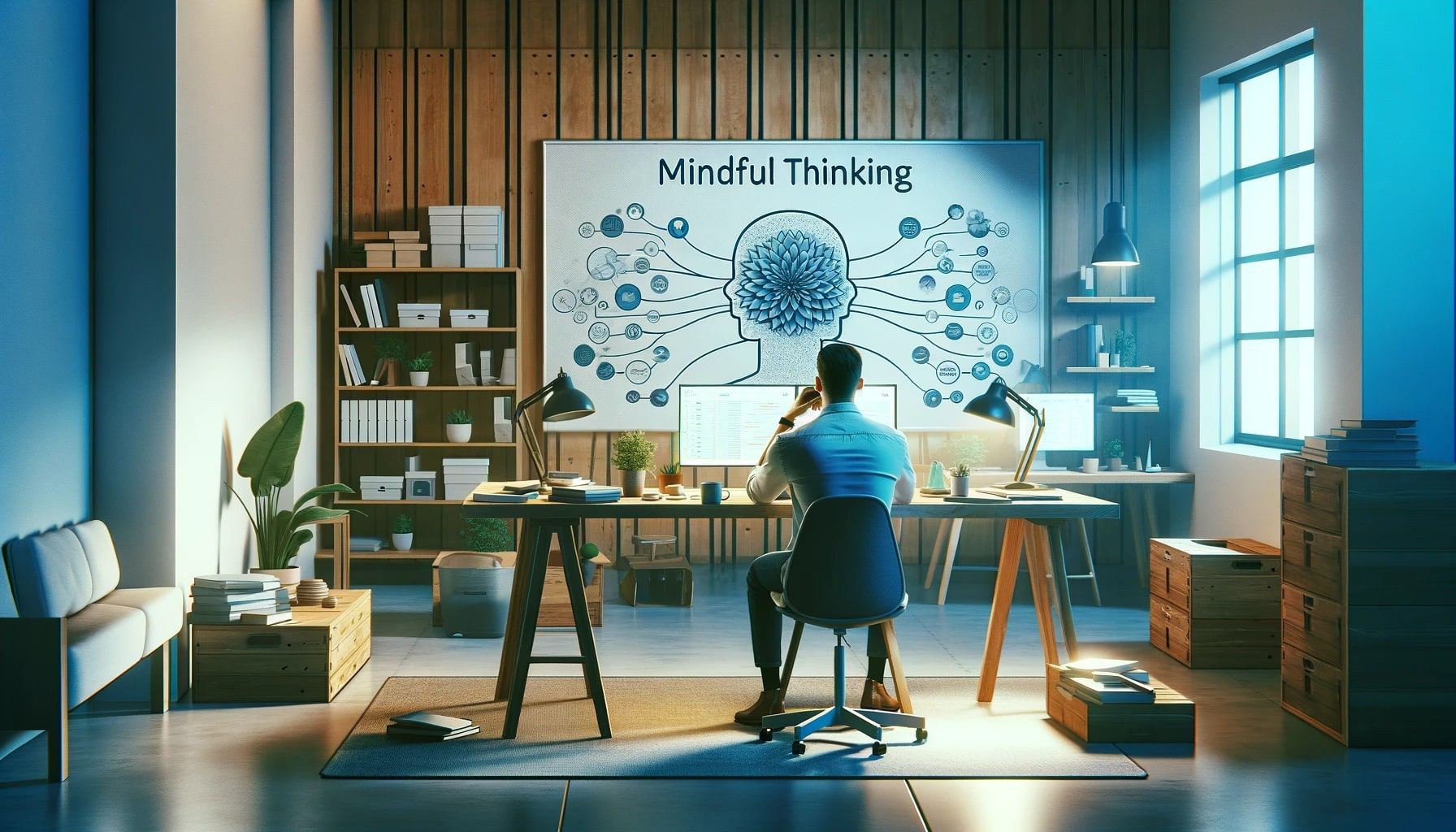Mindful Productivity: Embracing the Essence of Efficiency
In the relentless pursuit of success, it's easy to fall into the trap of constant labor, losing sight of true efficiency. Mindful productivity isn't about working harder but about working smarter. Consider the story of two woodcutters: the first toiled under the scorching sun, cutting wood tirelessly, while the second, employed by the same company, cut more wood and received a salary increase after a year. The first woodcutter, perplexed by this, was advised to improve his performance. Despite trying harder, he couldn't match his colleague's output and sought the secret behind the second woodcutter's success.

This narrative sets the stage for understanding mindful productivity. It is a tale that underscores the importance of pausing to rejuvenate and enhance performance. The first woodcutter, despite his hard work, could not surpass his colleague's output, not because of a lack of effort, but because of a lack of strategy. The second woodcutter understood the value of pausing to sharpen his saw, thereby enhancing his capability to cut more wood with less effort.
The lesson here is clear: excelling in our endeavors requires cultivating a practice of regular self-improvement and reflection. It's about recognizing when to pause and sharpen our tools, both literally and metaphorically, which in turn, leads to greater productivity and efficiency.
What is Mindful Thinking in the Context of Productivity?

Mindful thinking is the conscious effort to be present and fully engaged in the current task, with an awareness of our thoughts and actions. In a work environment, this translates to focusing on the task at hand with full concentration, minimizing distractions, and maintaining a clear and calm state of mind. It's about being aware of our work habits and recognizing when we are merely busy versus being truly productive.
Relating this to the woodcutter's story, the second woodcutter's approach exemplifies mindful thinking. He worked with intention, taking breaks to sharpen his saw, which allowed him to rest and refocus. This strategic pause enabled him to approach each tree with renewed energy and effectiveness.
Mindful thinking in the context of productivity is about understanding that our mental resources are finite and need replenishment. It's about knowing when to push forward and when to step back for a moment of rest and reflection. Just as the second woodcutter took time to sharpen his saw, we must take time to sharpen our minds.
Mindfulness: The Core of Enhanced Work Performance

Mindfulness involves an awareness of our thoughts, emotions, and sensations without judgment, allowing us to respond to work challenges with clarity and composure. This state of being is not only beneficial for personal well-being but also for productivity in the workplace.
The woodcutter's story illustrates the impact of mindfulness on work. The second woodcutter, who outperformed his colleague, did so by incorporating mindfulness into his routine. His regular breaks to sharpen his saw were moments of mindfulness, where he stepped away from the chaos of cutting to tend to his tool and his mind. This practice enabled him to cut more trees with less effort, demonstrating that mindfulness can lead to greater efficiency and output.
Adopting a mindful approach to our work can enhance our performance. It helps us to focus on the present task, reduces stress, and fosters a sense of calm amidst the demands of our professional lives. It encourages us to work not just harder, but smarter, by recognizing the value of quality over quantity.
Developing a Growth Mindset for Personal and Professional Success
A growth mindset, the belief that our abilities and intelligence can be developed through dedication and hard work, is a vital component of personal and professional success. It's the mindset that allows us to view challenges as opportunities for growth rather than obstacles. The second woodcutter's attitude exemplifies this mindset. He saw the need to sharpen his saw not as a hindrance but as a necessary step for improvement.
Strategies for fostering a growth mindset include embracing challenges, persisting in the face of setbacks, and learning from criticism. It's about understanding that effort leads to mastery and that our potential is not fixed but can be cultivated through perseverance and resilience. By adopting a growth mindset, we open ourselves to continuous learning and self-improvement, which are essential for personal growth.
The second woodcutter's story teaches us that success is not solely the result of innate talent or luck but is also influenced by our attitudes and actions. By choosing to sharpen his saw, he demonstrated a commitment to growth and self-improvement. This mindset not only led to his professional advancement but also serves as a model for how we can approach our own personal and professional development.
Entering the Flow State: Lessons from the Efficient Woodcutter

The concept of the flow state, a mental state in which a person is fully immersed in an activity with a feeling of energized focus and enjoyment, is crucial for achieving peak performance. The second woodcutter's method of taking breaks to sharpen his saw can be seen as a way of entering this flow state. By ensuring his tool was at its best, he could engage with his work without interruption, maintaining a rhythm that fostered a deep sense of focus and productivity.
Being in a flow state means that we are so absorbed in our work that time seems to fly by, and our productivity soars. The efficient woodcutter's approach to his task allowed him to enter this state repeatedly throughout his workday. He understood that by taking care of his tools and himself, he could sustain a level of performance that was both high-quality and enjoyable.
To achieve a flow state in our own work, we must create the right conditions. This includes setting clear goals, ensuring our tasks are challenging yet achievable, and minimizing distractions. By learning from the efficient woodcutter, we can strive to find our flow in our daily tasks, leading to greater satisfaction and success in our endeavors.
Cultivating Mental Clarity for Better Decision Making

Mental clarity is the state of having a clear understanding and sharp focus, which is essential for making sound decisions and achieving mindful productivity. It involves the ability to process information effectively, prioritize tasks, and approach challenges with a composed mind. Cultivating mental clarity is not only beneficial for decision-making but also for overall mental health and well-being.
Techniques for improving mental clarity include mindfulness practices such as meditation, deep breathing exercises, and regular breaks to refresh the mind. These practices help to reduce mental clutter and enhance our cognitive abilities. Just as the second woodcutter took breaks to sharpen his saw, we too must take breaks to sharpen our minds.
Improving our mental clarity can make us more effective in our work. This leads to better decision-making, as we are able to see the bigger picture and make choices that align with our goals and values. With a clear mind, we can navigate the complexities of our professional lives with greater ease and confidence.
The Role of Mindfulness in Personal Growth

Mindfulness practices play a significant role in personal development, as they help us cultivate self-awareness, emotional intelligence, and resilience. By integrating mindfulness into our daily lives, we can enhance our ability to cope with stress, improve our relationships, and foster a deeper sense of purpose and fulfillment.
The woodcutter's story provides valuable insights into the importance of mindfulness for personal growth. The second woodcutter's practice of taking breaks to sharpen his saw was not only a strategy for work efficiency but also a form of mindfulness that contributed to his personal development. By stepping away from his labor to tend to his tool, he was practicing self-care and giving himself the space to recharge, both physically and mentally.
Integrating mindfulness practices into our lives can take many forms, such as setting aside time for meditation, engaging in reflective journaling, or simply being present during everyday activities. These practices help us to cultivate a deeper connection with ourselves, understand our motivations, and align our actions with our core values. As we become more mindful, we begin to notice the subtle shifts in our thoughts and emotions, and we learn to navigate them with grace and intention.
Enhancing the Work Environment with Mindful Productivity
Applying the principles of mindful productivity can have a transformative effect on the work environment. It encourages a culture of focus, intention, and well-being, which not only boosts individual performance but also contributes to a more harmonious and productive workplace. By recognizing the value of taking breaks to sharpen our saw, we can foster an atmosphere where employees feel supported in their pursuit of excellence.
A case study that compares both woodcutters' approaches to work can provide valuable insights into how mindful productivity can be implemented in a real-world setting. The first woodcutter, who worked tirelessly without pause, represents a common scenario where employees are driven to exhaustion in the name of productivity. This approach often leads to burnout, decreased job satisfaction, and a decline in the quality of work.
In contrast, the second woodcutter's method of taking regular breaks to sharpen his saw reflects a mindful approach to work that prioritizes efficiency and well-being. This approach can be adopted in the workplace by encouraging regular breaks, providing opportunities for professional development, and creating a supportive environment that values the mental and physical health of employees. By enhancing the work environment with mindful productivity, organizations can achieve better outcomes while fostering a positive and sustainable work culture.
Balancing Effort and Mindfulness for Peak Productivity
Achieving peak productivity requires a delicate balance between effort and mindfulness. It is not enough to work hard; we must also work smart by incorporating mindful practices into our routines. Strategies for combining hard work with mindful practices include setting clear goals, managing time effectively, and being intentional about when and how we focus our energies.
The woodcutter's story offers valuable lessons on maintaining this balance. The first woodcutter's relentless effort without strategic breaks led to diminishing returns, while the second woodcutter's mindful approach resulted in greater productivity and success. This teaches us that taking the time to sharpen our saw—whether it's through meditation, exercise, or learning new skills—can enhance our ability to work hard and achieve our goals.
Integrating mindful practices into our daily lives can create a sustainable rhythm of productivity that allows us to perform at our best without sacrificing our well-being. This balance is crucial for long-term success and fulfillment, both in our personal and professional lives.
Integrating Mindful Productivity into Daily Life
In conclusion, mindful productivity is a powerful approach that can revolutionize the way we work and live. It is about recognizing the importance of pausing to sharpen our saw, both literally and figuratively, to enhance our efficiency and effectiveness. By embracing the principles of mindful productivity, we can unlock a higher level of performance and satisfaction in our daily tasks.
The story of the two woodcutters serves as a poignant reminder of the value of mindfulness in our pursuit of success. It teaches us that taking the time to cultivate our minds and spirits is not a luxury but a necessity for achieving our full potential. As we integrate these practices into our lives, we can look forward to a future where productivity and well-being go hand in hand.
We encourage you to begin this journey of mindful productivity today. Start by taking small steps to incorporate mindfulness into your routine, whether it's through meditation, reflective journaling, or simply being present in your daily activities. With ongoing practice and adaptation of these principles, you can transform your work and life into a more fulfilling and purposeful experience.







